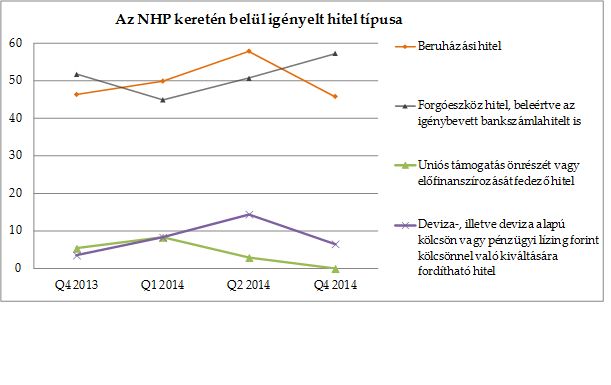Within the framework of the SME Outlook research, since January 2005 the HCCI Institute for Economic and Enterprise Research (IEER) conducts a quarterly analysis of the situation of small and medium sized enterprises, their short-term prospects, as well as the economic and institutional factors affecting this business group. For this project a total of 300 companies operating within the fields of manufacturing, construction and services are surveyed and the data is analysed in every quarter. The structure of the sample remains the same from quarter to quarter, with the companies surveyed representing the economic performance and sector distribution of small and medium sized enterprises in Hungary.
On June 1, 2013, the National Bank of Hungary (NBH) announced the Funding for Growth Scheme (FGS; in Hungarian: Növekedési Hitelprogram - NHP), the aim of the program was to support small and medium-sized enterprises in accessing forint- denominated loans, to strengthen financial stability, and to reduce external vulnerability of the Hungarian economy. The FGS consists of three pillars. Under the fist pillar the NBH provided collateralized refinancing loans to its monetary policy counterparties up to a total amount of HUF 425 billion. Under the second pillar the NBH provided refinancing loans to convert foreign currency loans of small and medium-sized enterprises into forint loans up to a total amount of HUF 325 billion. (Under the third pillar the NBH helped credit institutions to reduce their external foreign currency liabilities via FX swaps).
In this report we present the results of four SME Outlook quarterly surveys (October 2013, January 2014, April 2014 and October 2014), which covers in totally 1505 small and medium sized enterprises. In those quarterly SME Outlook surveys the leaders of small and medium-sized enterprises were asked about bank loans and the FGS by the HCCI Institute for Economic and Enterprise Research (IEER).
The results show that nearly 60% of small and medium-sized enterprises had some form of bank loan. The most common type of credits was working capital loan (including bank loans) during each survey period. Results show that companies that export a maximum of 50% of their whole production were the most likely to have a loan, as well as companies with expectation of investment change.
During the four waves of the survey companies hold mostly forint-denominated loans and around 30% of companies had a euro-based loan. Euro-based loan was mainly used by export-oriented companies, manufacture sector companies and medium-sized companies.
Generally every fifth SME applied for loan under the FGS. Over all periods of the survey, investment loans and working capital loans were the most demanded. More and more companies with positive opinion about current business situation were willing to apply for loan under the FGS, while companies with negative opinion were less likely to do so.

